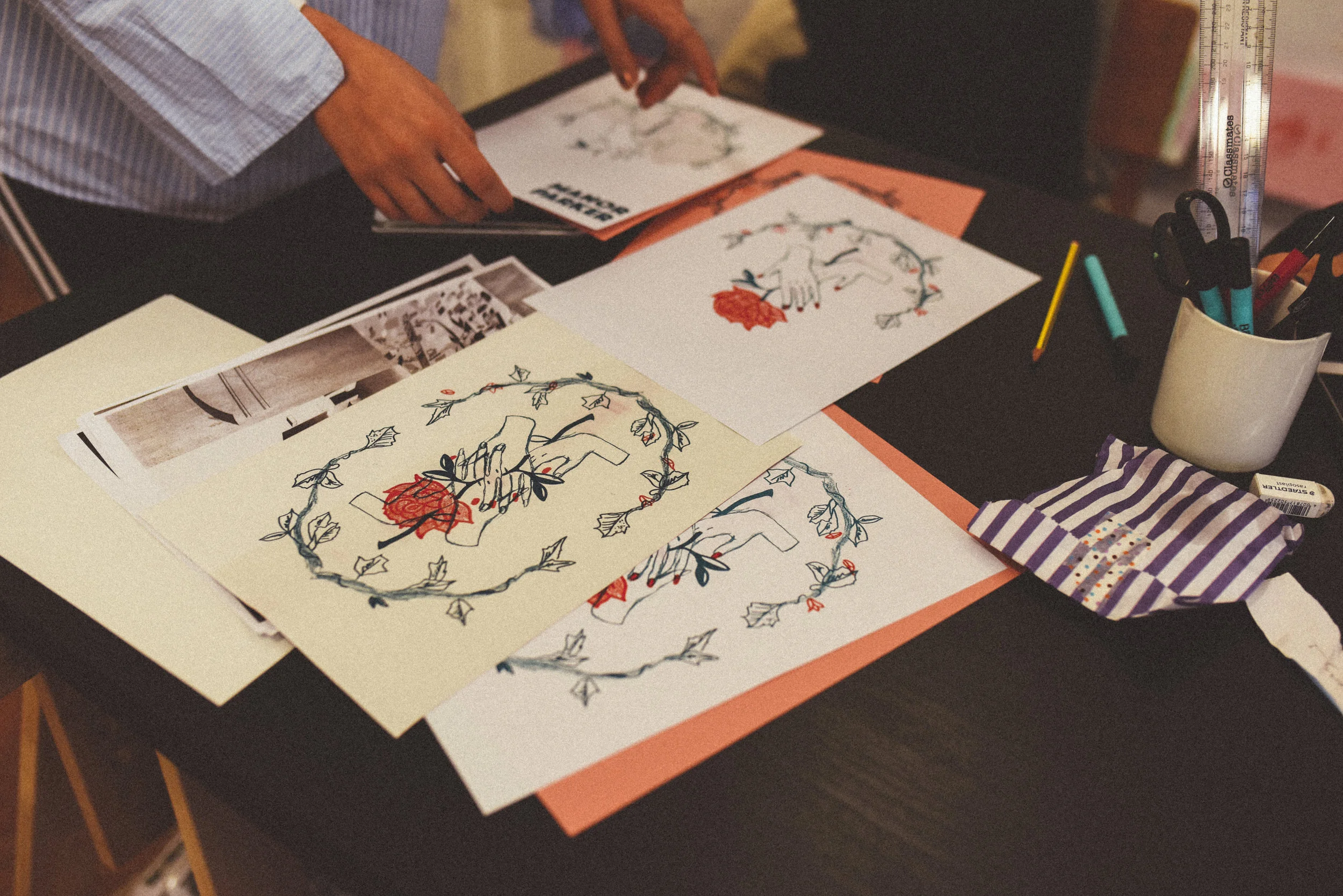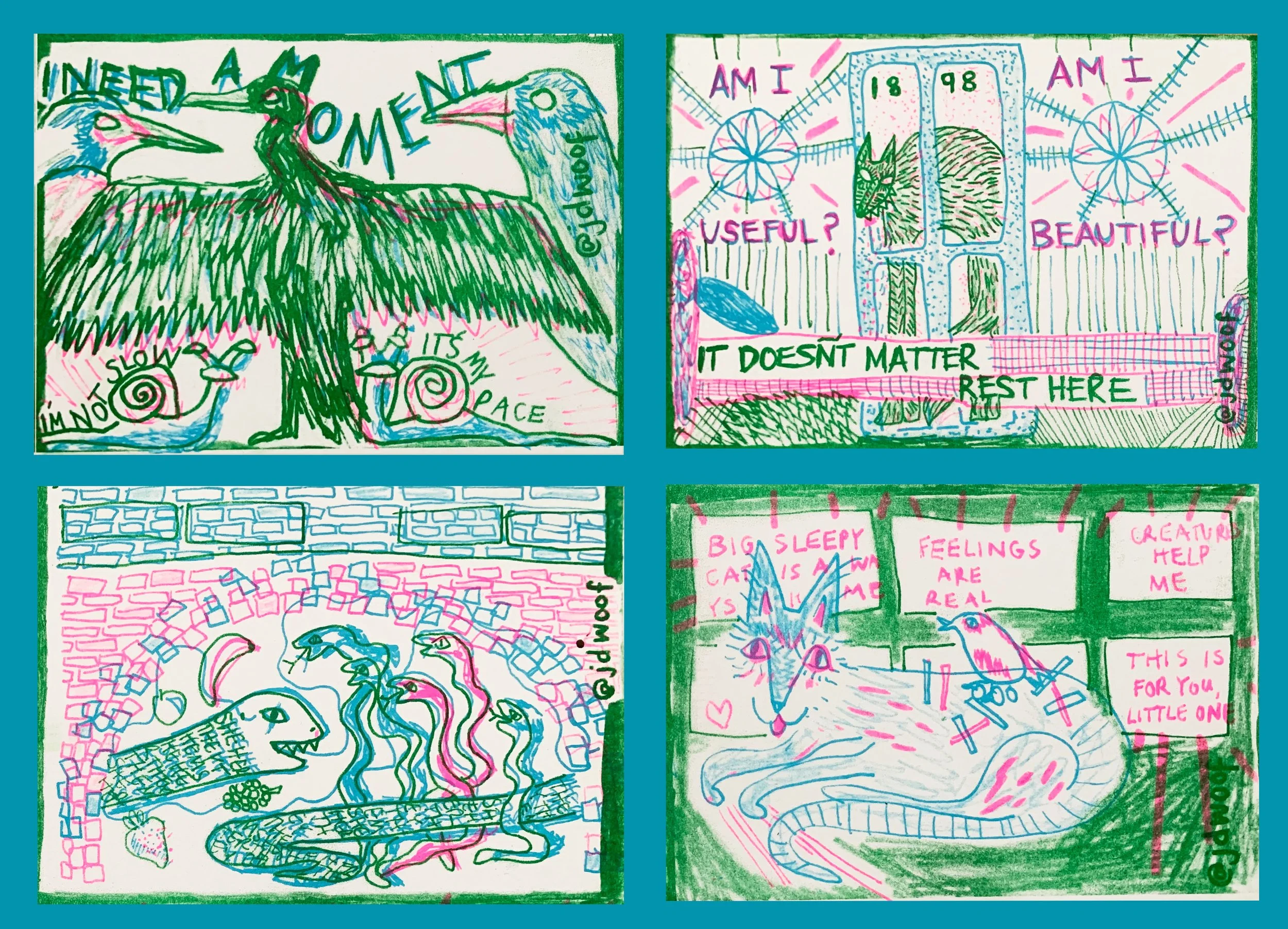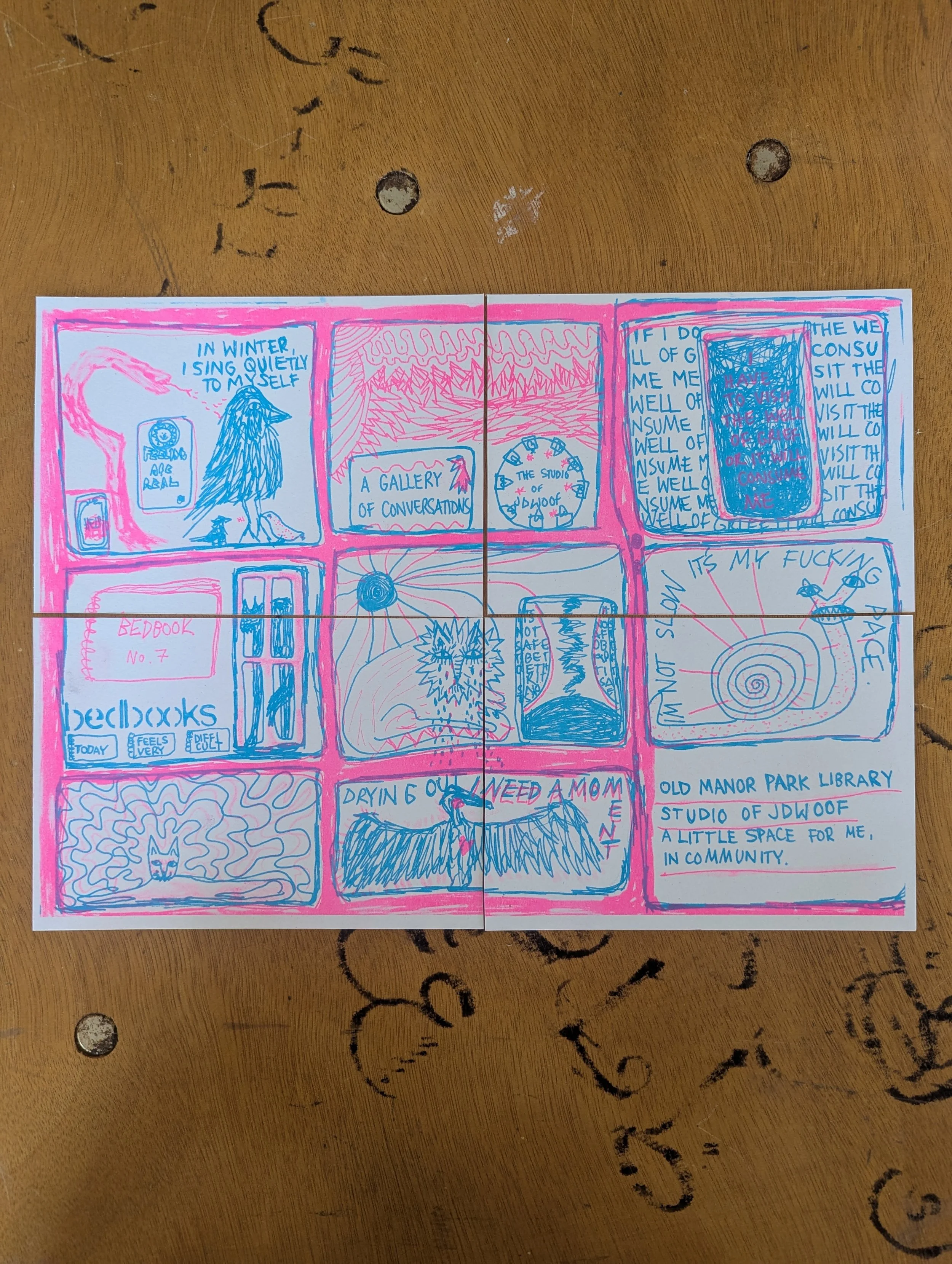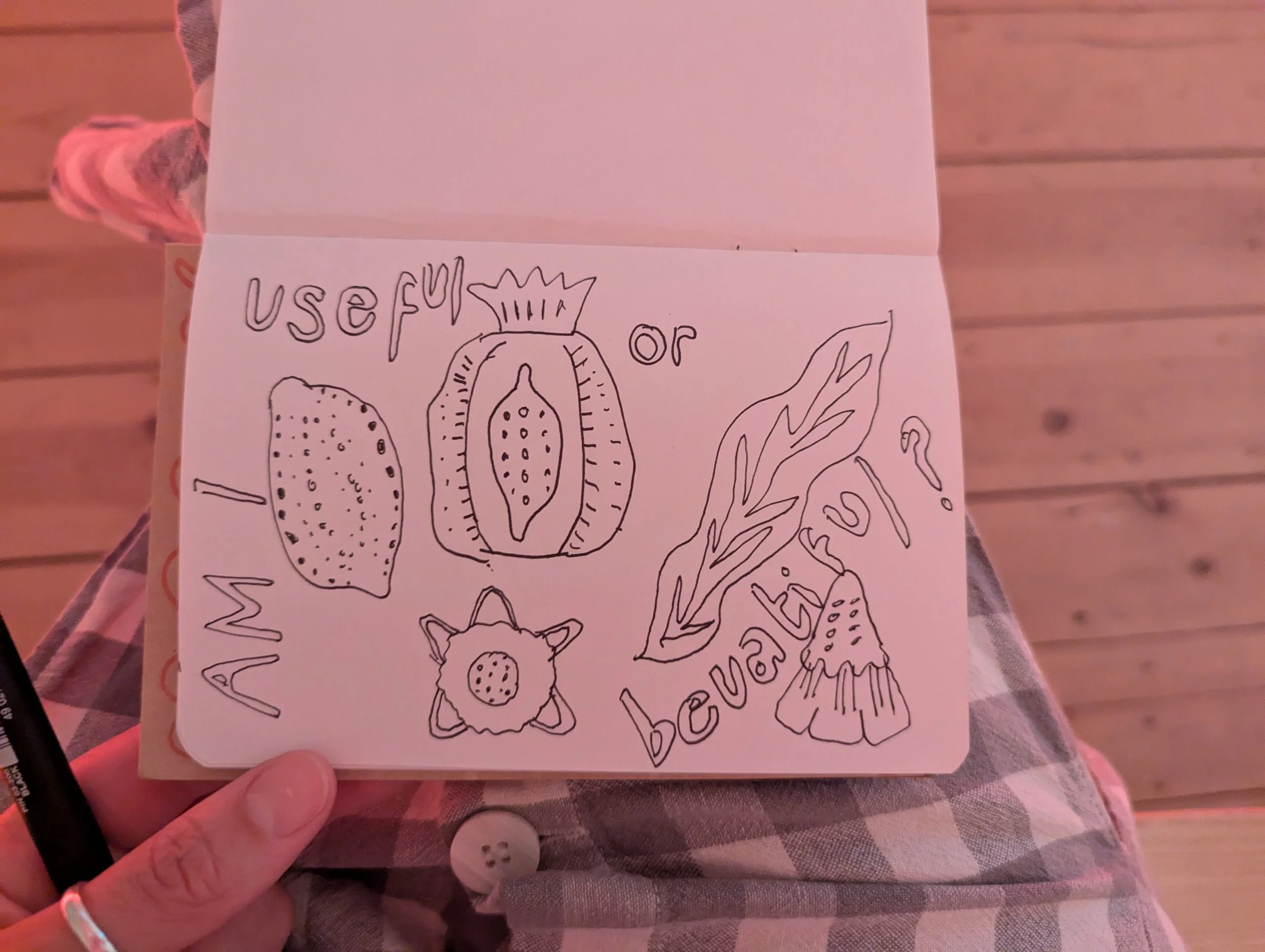Drawing on Heritage: Jo Wood aka jdwoof
/set of postcards by Jdwoof
Earlier this summer, Rabbits Road Press commissioned four local artists to develop a set of risograph printed cards celebrating any aspect of Newham’s heritage that spoke to them. Supported by Newham Heritage Month, the project, Drawing on Heritage, was inspired by the work of celebrated local artist Magde Gill (1882-1961) who created many drawings on postcards. As part of their artist residency, each of the commissioned artists, Amandine Forest-Aguié, Maryam Huq, Jo Wood, and Maryam Adam, spent one month visiting sites, doing research and learning about risograph printing. In this Drawing on Heritage blog series, each artist shares their residency experience. Join us for our Drawing on Heritage: Postcard Launch event which will be part of Newham Heritage Month this September 2025. The event will take place at Rabbits Road Press on Saturday September 27th 4-7pm, it’s free to attend but booking is required. Book your free place here.
Artist Biography
Jo Wood aka jdwoof is a self-taught artist, using mark-making, conversation and movement to explore ways to connect to herself, to other humans and to her environment, to support herself in challenging times. Jo often uses discarded materials because she thinks there is enough ‘stuff’ out there for us to be inspired by and experiment with. ‘There is so much opportunity and possibility if we can notice it – in our own bodies, in conversations, in rubbish we find – so my practice is often helping myself to be in the state where I can do that noticing.
Residency Reflection by Jo Wood
I was excited to see this commission opportunity and delighted when I was one of the selected four artists. I live close to Rabbits Road Press (RRP) and have got so much from taking part in their risograph workshops and zine fairs. I’d been admiring the Old Manor Park Library, where they are based, for a while, but thought it was empty. It was through RRP that I came to know about the other artist studios there - where I now have a little studio of my own. I was (and continue to be) keen to be more involved with this group of people who are socially and politically engaged, led by Muslim women, and based in the community I live in.
Me outside my studio. Credit: Nathan Clarke Photography
Through the application process, I learnt more about Madge Gill, a local artist who lived in East Ham later in her life. I connected a lot with her style; I also like repeating patterns, and drawing on small things and big things. My favourite art is when it looks a bit unnerving and unplanned. Madge Gill is described as an outsider artist. Outsider art has become one of those things which can feel guarded by people who say they know what it REALLY means. The way I think about it, it’s art made by people who are more on the margins of society. People who are part of groups/identities which are usually not privileged or valued. They probably haven’t had a traditional art school training. I don’t feel particularly comfortable with the label of outsider artist, even though I fit into that description, probably because I’m worried someone will tell me I’m wrong or I’m not outsider enough.
Anyway. Madge Gill was born an ‘illegitimate’ Victorian child and sent to Canada due to the shame she resembled for her family. When she came back she got into art and would make huge amounts of work whilst being possessed by a spirit called Myrinenest. I could relate to this, as I often understand myself better when I think about creatures representing different parts of me. These started out as creatures I compulsively drew or painted repeatedly, and have now come to understand them more. I also imagined Madge Gill found art helped her in supporting her in challenging times, which is the main reason why I make art. Whilst I felt this connection to Madge Gill, I wasn’t sure how to connect my interests in art as a support for mental health, to the history of Newham.
Artwork by Madge Gill
The first morning of this commission was spent in the archives in Stratford Library. We got to learn about the archive, look at many of Madge Gill’s original postcards and also have access to lots of photos from the borough. As art supports me, I wanted to connect themes of mental health and art to Newham. I had a look through the binder which listed all the categories of photos across maybe 200-300 binders, to see if something seemed relevant. I found a section on Public Health and Asylums and thought I’d start there. Bizarrely but maybe fittingly with some attitudes to the ‘insane’, this section also contained photos of sewers in Newham, including the Great Tommy Lee Sewer. I wondered who Tommy Lee was and why he got a sewer named after him. There were photos labelled “Unemployed Relief Work” from Wanstead Park in 1908. I found a photo of a group of mostly men in tophats standing around for the unveiling of West Ham Lunatic Asylum. I thought that they looked like a nightmare. I found a workhouse in West Ham and a Casualty Shock room in Albert Dock Hospital, Harts Sanatorium and East Ham Isolation Hospital.
I then realised how much I wanted to look at Old Manor Park Library photos. Could I find photos of the room where my studio is? Maybe I also needed a break from the above. I followed my interest and found photos of the foundation stone being unveiled in 1904 (lots more tophats) and presumably with Passmore Edwards in attendance. He funded a number of the local older buildings here, including the former library in Plashet Park, where I spent a 9-month art residency when it was Applecart Arts, before they had to close due to lack of funding. There were also photos from 1989 when it was still a library. The RRP studio was the children’s library and the room where my studio is, was the adult library. Heiba, from RRP, also hadn’t seen these photos before and it was nice to share the excitement and interest with someone else.
MY Studio in old manor park library
I also had a sudden realisation of how everything could connect for the commission - my studio, in this Victorian building, is a significant place for me, in supporting me in my artistic practice and therefore supporting me. It’s a special place just for me, which is also in my community. I get to play or be angry or have peace or have a chat or paint when I go there.
In the afternoon session, we had a risograph workshop and it was my first experience of printing postcards. I decided to make a set which was one image over an A4 page which would be chopped up into 4 postcards. I liked the idea that they were postcards on their own but if you had the set, you could make one big image. My studio is a little room with glass and wood walls with art in the front (that people can see when they walk past) and I decided to draw the front, over the A4 page. The idea flowed easily and I wondered if I had already made my final postcards for the commission.
On our second day together, we spent the morning at the William Morris Gallery in Walthamstow. I didn’t know about him at all before, apart from visually, and I was interested to learn about his political and social engagement and growing awareness of how inaccessible his work/wallpaper was to most people. Our invitation was to draw things we liked. I enjoyed copying some repeated patterns. I saw his quote “Have nothing in your houses that you do not know to be useful or believe to be beautiful". I’ve found this quote appealing before, as a way to help me decide what I want around me where I live. But for the first time, I applied it to humans/myself and I didn’t like it. I don’t want to need to be aesthetically appealing or productive, to be valued.
For the afternoon workshop, we were printing in three colours, which was a first for me. It suddenly became ten times more complicated to think about. I love risograph, I love that it is a totally different way, for me, to think about making art. I love the surprises and the squiffiness. I’ve also sometimes felt really disappointed by what comes out, which makes it even more of an exciting rollercoaster. For this session, I made a postcard about four places in Newham which are significant to me. This was one of the times I felt disappointed. I realised how good block colours look and I wasn’t using them, particularly because of them being made from my line drawings rather than collage or printed work.
With the final postcards, I got really stuck. I felt the pressure of making something that would be the final version. I decided I wanted to do three-colour printing again which involved a lot of thinking. I pre-thought a lot about the imagery and conceptual messages I wanted in each postcard. This is very opposite to how I normally work. Usually, I start from a feeling, maybe an overwhelming one. Or an observation or something in me or that I have noticed in being a human in the world. Or I have some images that I want to start from. I then work improvisationally and with my whole body. I follow the feelings rather than thinking a lot before taking action. With the postcards, I was hunched over three pieces of tracing paper, thinking about every element that would be included in them and what it meant to me and how it connected to this project. I wanted it to feel like my art - and the process is a huge part of that - but I was very aware that I had one submission, three bits of tracing paper and a imminent deadline.
In the end, probably with the help of the deadline, I managed to find a way to make the art in a way that felt loosey-goosey enough to feel like me/mine. On the day it was being printed, I kept checking my phone for a photo update. The excitement of the risograph outcome is so real! In the afternoon, Sofia sent me a photo and I felt relieved. They looked messy and strange and had come out different to how I’d imagined, but they looked and felt like my work.
Each one symbolises something important to me in living in this borough, which supports me every day; connection to nature, open spaces, wildlife and creatures. Retreat and rest at home. Valuing my own creative practice and the need for space for that. Being part of a community. Can you tell which is which?
Final postcards by JDwoof









